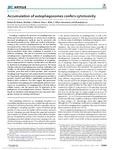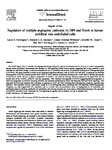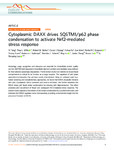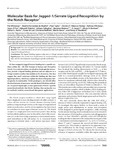Accumulation of autophagosomes confers cytotoxicity
| dc.contributor.author | Button, RW | |
| dc.contributor.author | Roberts, SL | |
| dc.contributor.author | Willis, TL | |
| dc.contributor.author | Hanemann, Clemens Oliver | |
| dc.contributor.author | Luo, Shouqing | |
| dc.date.accessioned | 2018-03-20T09:16:54Z | |
| dc.date.available | 2018-03-20T09:16:54Z | |
| dc.date.issued | 2017-07-03 | |
| dc.identifier.issn | 0021-9258 | |
| dc.identifier.issn | 1083-351X | |
| dc.identifier.uri | http://hdl.handle.net/10026.1/11110 | |
| dc.description.abstract |
Autophagy comprises the processes of autophagosome synthesis and lysosomal degradation. In certain stress conditions, increased autophagosome synthesis may be associated with decreased lysosomal activity, which may result in reduced processing of the excessive autophagosomes by the rate-limiting lysosomal activity. Thus, the excessive autophagosomes in such situations may be largely unfused to lysosomes, and their formation/accumulation under these conditions is assumed to be futile for autophagy. The role of cytotoxicity in accumulating autophagosomes (representing synthesis of autophagosomes subsequently unfused to lysosomes) has not been investigated previously. Here, we found that accumulation of autophagosomes compromised cell viability, and this effect was alleviated by depletion of autophagosome machinery proteins. We tested whether reduction in autophagosome synthesis could affect cell viability in cell models expressing mutant huntingtin and α-synuclein, given that both of these proteins cause increased autophagosome biogenesis and compromised lysosomal activity. Importantly, partial depletion of autophagosome machinery proteins Atg16L1 and Beclin 1 significantly ameliorated cell death in these conditions. Our data suggest that production/accumulation of autophagosomes subsequently unfused to lysosomes (or accumulation of autophagosomes) directly induces cellular toxicity, and this process may be implicated in the pathogenesis of neurodegenerative diseases. Therefore, lowering the accumulation of autophagosomes may represent a therapeutic strategy for tackling such diseases. | |
| dc.format.extent | 13599-13614 | |
| dc.format.medium | Print-Electronic | |
| dc.language | en | |
| dc.language.iso | en | |
| dc.publisher | Elsevier BV | |
| dc.subject | autophagy | |
| dc.subject | cell death | |
| dc.subject | lysosome | |
| dc.subject | mTOR complex (mTORC) | |
| dc.subject | neurodegenerative disease | |
| dc.subject | Animals | |
| dc.subject | Autophagosomes | |
| dc.subject | Cell Line, Tumor | |
| dc.subject | Cell Survival | |
| dc.subject | Cells, Cultured | |
| dc.subject | Embryo, Mammalian | |
| dc.subject | Green Fluorescent Proteins | |
| dc.subject | HEK293 Cells | |
| dc.subject | Humans | |
| dc.subject | Lysosomal-Associated Membrane Protein 2 | |
| dc.subject | Lysosome-Associated Membrane Glycoproteins | |
| dc.subject | Lysosomes | |
| dc.subject | Mice | |
| dc.subject | Mice, Knockout | |
| dc.subject | Microscopy, Electron, Transmission | |
| dc.subject | Nerve Tissue Proteins | |
| dc.subject | Neurons | |
| dc.subject | Qa-SNARE Proteins | |
| dc.subject | RNA Interference | |
| dc.subject | Recombinant Fusion Proteins | |
| dc.subject | TOR Serine-Threonine Kinases | |
| dc.subject | Tumor Cells, Cultured | |
| dc.subject | Vesicular Transport Proteins | |
| dc.title | Accumulation of autophagosomes confers cytotoxicity | |
| dc.type | journal-article | |
| dc.type | Comparative Study | |
| dc.type | Journal Article | |
| plymouth.author-url | https://www.webofscience.com/api/gateway?GWVersion=2&SrcApp=PARTNER_APP&SrcAuth=LinksAMR&KeyUT=WOS:000407942400002&DestLinkType=FullRecord&DestApp=ALL_WOS&UsrCustomerID=11bb513d99f797142bcfeffcc58ea008 | |
| plymouth.issue | 33 | |
| plymouth.volume | 292 | |
| plymouth.publication-status | Published online | |
| plymouth.journal | Journal of Biological Chemistry | |
| dc.identifier.doi | 10.1074/jbc.M117.782276 | |
| plymouth.organisational-group | /Plymouth | |
| plymouth.organisational-group | /Plymouth/Faculty of Health | |
| plymouth.organisational-group | /Plymouth/Faculty of Health/Peninsula Medical School | |
| plymouth.organisational-group | /Plymouth/REF 2021 Researchers by UoA | |
| plymouth.organisational-group | /Plymouth/REF 2021 Researchers by UoA/UoA01 Clinical Medicine | |
| plymouth.organisational-group | /Plymouth/Research Groups | |
| plymouth.organisational-group | /Plymouth/Research Groups/Institute of Translational and Stratified Medicine (ITSMED) | |
| plymouth.organisational-group | /Plymouth/Research Groups/Institute of Translational and Stratified Medicine (ITSMED)/CBR | |
| plymouth.organisational-group | /Plymouth/Users by role | |
| plymouth.organisational-group | /Plymouth/Users by role/Academics | |
| plymouth.organisational-group | /Plymouth/Users by role/Researchers in ResearchFish submission | |
| dc.publisher.place | United States | |
| dcterms.dateAccepted | 2017-07-03 | |
| dc.identifier.eissn | 1083-351X | |
| dc.rights.embargoperiod | Not known | |
| rioxxterms.versionofrecord | 10.1074/jbc.M117.782276 | |
| rioxxterms.licenseref.uri | http://www.rioxx.net/licenses/all-rights-reserved | |
| rioxxterms.licenseref.startdate | 2017-07-03 | |
| rioxxterms.type | Journal Article/Review | |
| plymouth.funder | Tackling autophagy and apoptosis for the potential therapy of Huntington's Disease::MRC |





